Update (06.12.2017): Second go at making a PCB layout. This time I didn’t need as many revisions.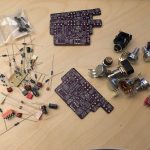
Goal was to fit everything on a board and make room for six board-mounted pots (to cut down on the tedious wiring and make things a bit more efficient). Again, since it’s a PCB, I added a u-controller to handle soft-touch stomp switch toggling via relays and LED control, while also including the same reverse polarity power protection I tried on the Workhorse board.
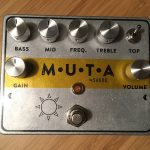
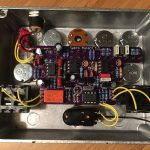
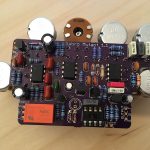 I’m really happy I managed to get everything together with space enough for all the hardware to fit in a 1590BB 🙂
I’m really happy I managed to get everything together with space enough for all the hardware to fit in a 1590BB 🙂
A/B testing with the vero build and I can’t hear any difference, so that’s good too.
This is another attempt at a high-gain distortion effect. The “Lighthaus” I did previously sounds great, but can get a bit noisy, so that was a design goal for this next one.
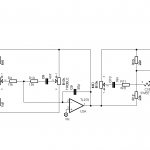 The “Mutant” (I don’t know why it ended up with that name, suggestions for a better one?) is another high-gain, “amp-like” if you will, distortion effect with a very flexible EQ section and a cool sound.
The “Mutant” (I don’t know why it ended up with that name, suggestions for a better one?) is another high-gain, “amp-like” if you will, distortion effect with a very flexible EQ section and a cool sound.
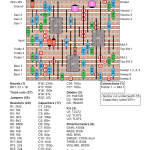 I used the Marshall Shredmaster circuit as a starting point, and the initial gain stages remain quite similar. But this is mostly where the similarities end.
I used the Marshall Shredmaster circuit as a starting point, and the initial gain stages remain quite similar. But this is mostly where the similarities end.
- The Bass and Treble controls were taken pretty much straight from the “Lighthaus”, which is to say it’s an active baxandall setup.
- The Mid control is something I borrowed from Douglas Self’s excellent book “Small Signal Audio Design”. It’s something called a Wien sweep filter; it’s an active Mid control with plenty of boost/cut, that can be placed at a wide range of frequencies.
- The Sweep control moves the Mid boost/cut either down towards the bass or up towards the treble side; what we would call “mid voicing” in the guitar world. At noon/centered it lines up with the baxandall control’s center frequency.
- I really, really like how the old ShredMaster circuit cuts a lot of the top end using large feedback capacitors, but it doesn’t work for every scenario, so I placed this on a “Top” switch, allowing for a more flexible choice. Activate to help get some of those liquid high-gain sounds, or deactivate to retain all of the brightness 🙂
- The circuit end with an active volume control. I could have kept the original passive one, but there’s a bit of an active theme going on here, and it’s more fun doing things a bit different.
![]()
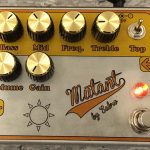 Brought this box with me to some friends without telling them what it was. Their first comment was that this sounds a lot like a big Marshall amp, so that was pretty spot on. We also got some fairly cool baritone-like sounds out of it with the gain at minimum (see settings in picture to the left). I thought the “Lighthaus” was fairly cool, but I’m absolutely loving this one! And it’s much more quiet, both on min gain/max volume and max gain/low volume, so design goal accomplished 🙂
Brought this box with me to some friends without telling them what it was. Their first comment was that this sounds a lot like a big Marshall amp, so that was pretty spot on. We also got some fairly cool baritone-like sounds out of it with the gain at minimum (see settings in picture to the left). I thought the “Lighthaus” was fairly cool, but I’m absolutely loving this one! And it’s much more quiet, both on min gain/max volume and max gain/low volume, so design goal accomplished 🙂
Let me know what you think if you give it a try.
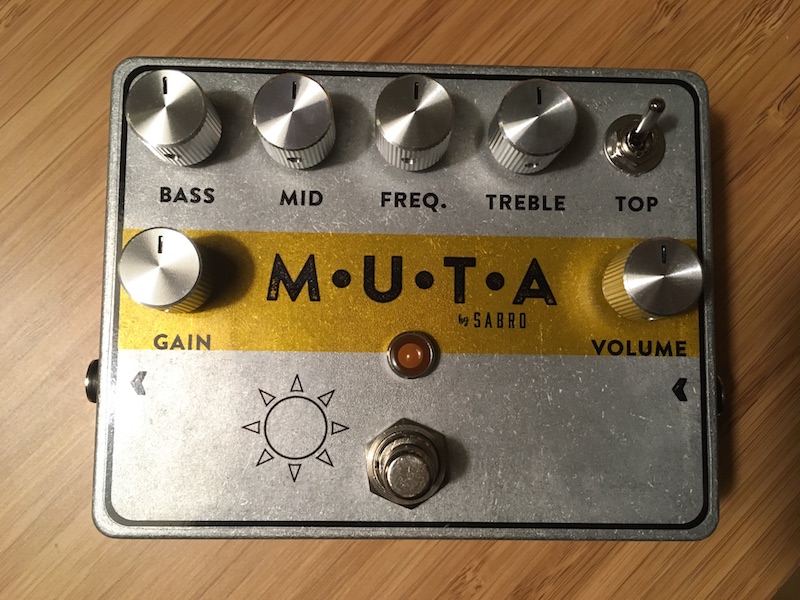
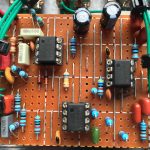
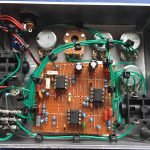
Hello Harald!
Is this still worth to built it versus other high gain pedals?
I was considering a Shredmaster but how does this compare to it?
Thanks
Jim: I missed a point about potentiometers. Don’t be offended, we all make simple mistakes or are even deceived! Did you make sure linear and audio taper potentiometers were used where needed? It sounds like the problem; that an audio taper is needed. Another problem is that if you’re looking for the lowest price for parts, some places will mislabel their stock (intentionally or not?). If you used a potentiometer from your own stock and it was just sitting unlabeled in a “parts-bin”, measure it while turning the knob. If it’s a discount part (sometimes counterfeit), the part number may not help, it could be an inexpensive linear when you want an audio taper. When I get discount parts I learned the hard way to measure them (and just about all parts). A semi unrelated funny story: I had a problem after completing a circuit, and I traced it to a discount WIMA capacitor. I took it out and measured it and the ESR was way off. I ground the casing off it and it was full of cheap SMD MLCC capacitors soldered together in parallel! I now only order discount parts that are non critical, I now tend to deal with authorized distributors or order directly from the manufacturer. Checking manufacturer sites is always a good idea if you’re designing, they often have many parts that distributors don’t have, and they tend to be good at getting shipments to you places where distributors can’t. It’s hard to get parts in some places in the world. Sometimes, remailer services are needed, they’re all over the world. An internet colleague in Africa has parts delivered by bicycle! Also, many manufacturers offer free samples, and that’s great for a one-off project!
Sorry for my rambling.
Looking at the schematic (it’s too difficult for me to figure out the breadboard layout), I don’t see how the power is switched. It’s best to switch it through an input or output jack. In my ‘old style pedals’, I used to use a two color LED: Red for bypassed and Green for active. If the LED is off there’s no power. Maybe the power and bypass are on the stomp switch? In bypass, only bypass the distortion, not the tone and some gain section(s) for the most part. This is where the Mid control can come in handy. Without a distortion the sound is more like an acoustic, which has an abundance of mid-range, especially if the D and G strings are a heavier than usual gauge.
The switch isn’t a problem, just change the gain resistor to your taste. Maybe add a low ‘limit’ resistor in series with a potentiometer instead of a switch? C13 can also be changed to a different value/frequency point.
Just some thoughts.
Hi, Jim
No, something is definitely wrong. It’s not subtle at all, the switch takes out/brings in lots of treble. Also, the mid shouldn’t cut away at any point.
Harold, finished the mutant. It is nice high gain dirt box. The tone stack bass and treble is very responsive, but on my build the mid cuts off at extreme left and right. Also the frequency pot does not sound like it does anything at all. I also get no change in sound with the use of the top switch. Is suppose to be subtle effect, because I can’t hear any change at all.